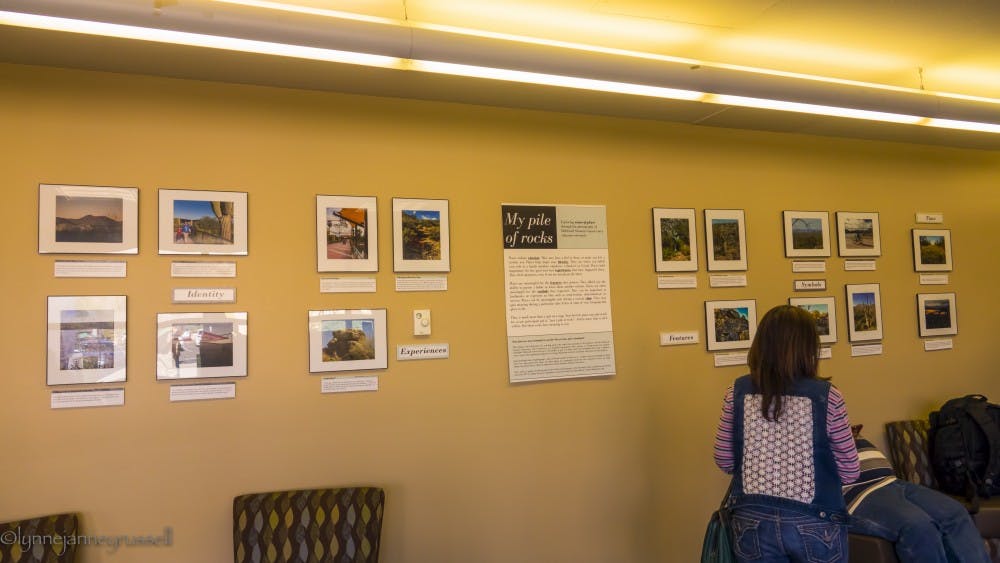Whether it’s surrounded by stalks of prickly plants, towering red rocks, or a vibrant sunrise, everyone has a place that feels like home.
A new study, conducted by Ryan Bleam and his 18 volunteers of the McDowell Sonoran Conservancy, an organization that protects the McDowell Sonoran Preserve, investigates what makes places meaningful to the people who are attached to them. After asking his participants to photograph the places that mean the most to them, the exhibit “My Pile of Rocks” was formed. No two photographs are the same as 18 perspectives hang in the Scottsdale Mustang Library auditorium through the first week of January.
Bleam, a Ph.D student in anthropology at ASU, recruited 18 stewards of the McDowell Sonoran Conservancy to aid him in his dissertation work studying the relationship between people and their community. Ryan will be diving further into his findings in a lecture on Nov. 22 from 5:30 to 7:30 p.m.
Bleam wanted to showcase the influence a place can have on a person and what they hold in a high regard.
“I am interested in how being a volunteer with this conservation organization helps foster a sense of place or a positive relationship to the community,” he said.
Bleam used a series of phases and a method called “photo voice” to measure how his stewards connected with their environment.
“They took 10 photographs and sent them to me as well as the latitude and longitude of where they took each photograph,” Bleam said. “I asked them about each photo, why it was meaningful, and how they interacted with that place, then me and my research team, which includes several ASU undergraduate research assistants, took that information and analyzed that data performing what is called text analysis.”
After applying codes to the data, Bleam observed six diverse themes, all of which are presented in the exhibition.
“Places can be meaningful for the emotions that they produce, either in the person who is in that place or a place itself can have an emotion,” he said. "A place can be important because it provides you an identity or helps you realize your identity, and places are important because of the experience, both positive and negative, that happen there.”
The talk will be an expanded showcase of the results of the study, which highlight all the ways places can be important to people.
“Places are important because of the features that they have or because of the symbols that they represent, and people often took pictures of saguaros or other desert plants that represented to them the tenacity of nature,” he said. “I also wanted to showcase how places can be important not necessarily for that geographical spot, but because of the time aspect of being in that place.”
The exhibit name originated from a weary participant who noted that all the places that were meaningful to them were just a pile of rocks. Bleam used this comment to encourage his participants not to take the best picture, but the most meaningful.
“We don’t give a lot of thought in our day-to-day about why places are meaningful to us — We take that for granted,” Bleam said. “Often that kind of reflection can lead to engaging with those type of places more and being more thoughtful about where we spend our time, where we put our effort, and the kind of experiences we pursue.”
Lynne Russell, a participant and volunteer chair of McDowell Sonoran Conservancy’s Core Leadership Team, said she thought about memories when taking her photographs for the study.
“I was thinking about memories, what drew me to the Preserve in the first place and what I had experienced in various locations that had significance to me, and when I go back to those locations, I have memories of particular times, people and emotions,” Russell said.
The volunteers were required to take five photographs inside the McDowell Sonoran Preserve as well as five photographs in Phoenix Valley out of the Preserve. For Russell, the photo on display is of the bridge at the Phoenix Zoo and represents a memory about her daughter.
“The reason that I selected that location was that years ago, they were raising money for the zoo and we bought a brick, so our daughters name is on that brick about halfway across the bridge,” she said. “Every time we go to the zoo, I look for that brick, and I think about my little girl and how much fun we had there.”
Laurie Jones was also a volunteer steward, and said she found it harder to take photographs outside the Preserve that she works to protect every day.
“I felt like when I was taking the pictures, I was conscious of ‘Would this be interesting for other people?’” she said. “It was neat to see my life summed up in 10 frames.”
Jones said she felt this study has made her more grateful to be able to have a foundation and a place where she feels a sense of home.
“It’s very obvious in an environmental setting that we want to protect the preserve, but you have to protect whatever means home to you,” she said.
The photographs of all stewards will be hanging in the Scottsdale Mustang Library auditorium until the first week of January and the free public lecture is on Nov. 22 at 5:30 to 7:30 p.m.
Correction: Due to a reporting error, a previous version of this article referred to the McDowell Sonoran Preserve as the Sonoran Nature Preserve. The article has been updated to reflect the change.
Reach the reporter at kasando1@asu.edu or follow @karismasandoval onTwitter.
Like The State Press on Facebook and follow @statepress on Twitter.




